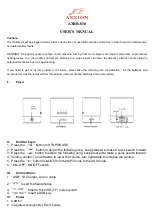
3.3.7 Load Sharing
Units with the built-in load sharing option contain terminals 89 (+) DC and 88 (-) DC. Within the frequency converter, these terminals connect to the DC bus in front
of the DC link reactor and bus capacitors.
The use of the load sharing terminals can take on two different configurations.
In one method, the terminals are used to tie the DC bus circuits of multiple frequency converters together. This allows for the possibility of one frequency converter
that is in a regenerative mode to share its excess bus voltage with another frequency converter that is in motoring mode. When applied correctly, this can reduce
the need for external dynamic brake resistors while also saving energy. In theory, the number of frequency converters that can be connected in this way is infinite;
however, the frequency converters must be of the same voltage rating. In addition, depending on the size and number of frequency converters, it may be necessary
to install DC reactors and DC fuses are required in the DC link connections and AC reactors on the mains. Attempting such a configuration requires specific
considerations .
In the second method, the frequency converter is powered exclusively from a DC source. This is a bit more complicated. First, a DC source is required. Second, a
means to soft charge the DC bus at power up is required. Last, a mains voltage source is required to power the fans within the frequency converter.
3.3.8 Specific Card Connections
Connector FK102, terminals 104, 105 and 106 located on the power cards, provide for the connection of an external temperature switch. The input could be used
to monitor the temperature of an external brake resistor. Two input configurations are possible. A normally closed switch may be connected between terminals
104 and 106 or a normally open switch between terminals 104 and 105. Should the input change states, the frequency converter would trip on an Alarm 27,
Brake
IGBT Fault
. The input SCRs would also be disabled to prevent further energy from being supplied to the DC bus. If no such input is used, or the normally open
configuration is selected, a jumper must be installed between terminals 104 and 106.
Connector FK103, terminals 100, 101, 102, and 103 located on the power cards, provide for the connection of mains voltage to allow powering the AC cooling
fans from an external source. This is required when the frequency converter is used in a load sharing application where no AC power is provided to the main input
terminals. To make use of this provision, the jumpers would be removed from terminals 100 and 102, 101 and 103. The auxiliary mains voltage power supply
would be connected to terminals 100 and 101.
The power card MK112, terminals 1, 2, and 3, and 4, 5, and 6 provide access to two auxiliary relays. The relays are wired to a terminal mounted in the inverter
cabinet above the MDCIC. These are form C sets of contacts, meaning one normally open and one normally closed contact on a single throw. The contacts are
rated for a maximum of 240 VAC, 2 Amps and a minimum of 24 VDC, 10 mA or 24 VAC, 100 mA. The relay can be programmed via par. E-24
Function Relay
to
indicate frequency converter status.
Terminal positions on the power card labelled MK400 and MK103 are reserved for future use.
High Power Service Manual for Unit Sizes 6x
44
3
Summary of Contents for AF-650 GP Series
Page 31: ...High Power Service Manual for Unit Sizes 6x 30 3...
Page 41: ...Illustration 3 7 Inverter section High Power Service Manual for Unit Sizes 6x 40 3...
Page 43: ...Illustration 3 8 Brake option High Power Service Manual for Unit Sizes 6x 42 3...
Page 97: ...High Power Service Manual for Unit Sizes 6x 96 7...
Page 111: ...High Power Service Manual for Unit Sizes 6x 110 8...
Page 121: ...High Power Service Manual for Unit Sizes 6x 120 9...
Page 134: ...11 Block Diagrams High Power Service Manual for Unit Sizes 6x 133 11...
















































